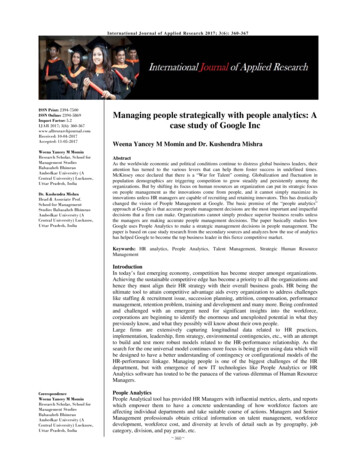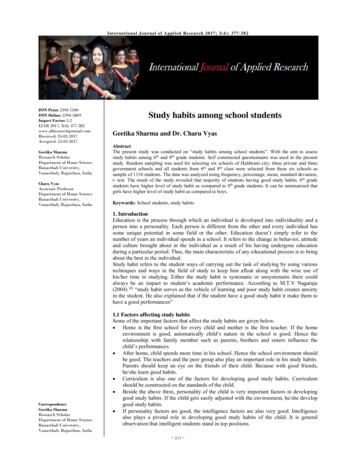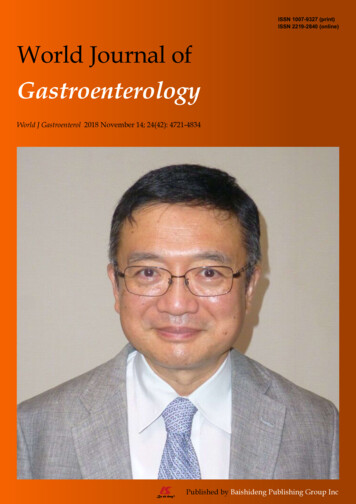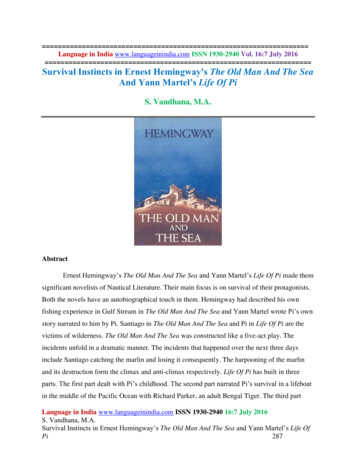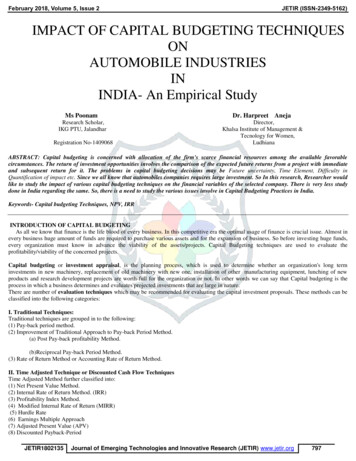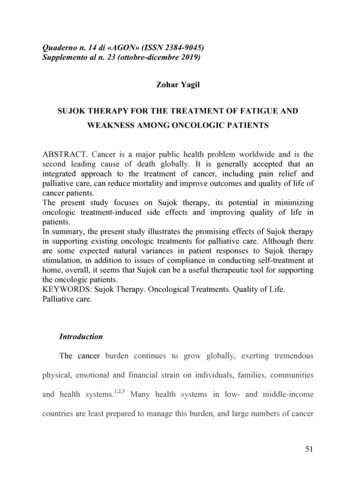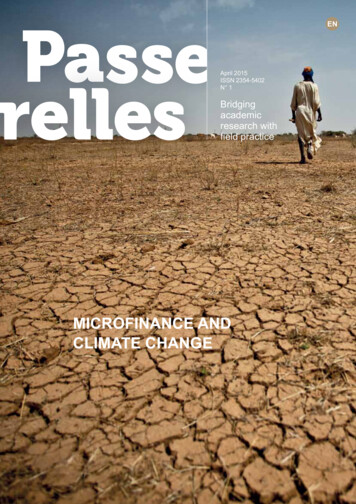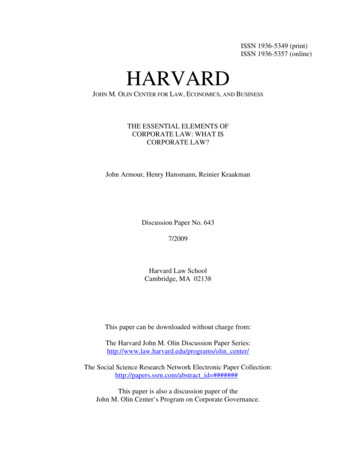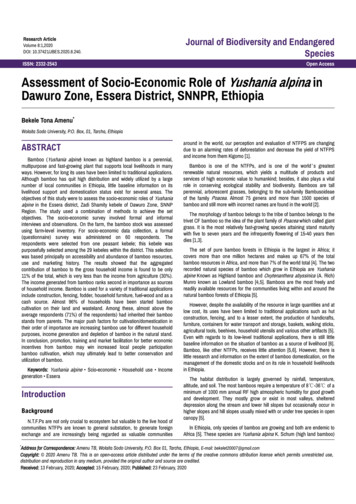
Transcription
Research ArticleVolume 8:1,2020DOI: 10.37421/JBES.2020.8.240.ISSN: 2332-2543Journal of Biodiversity and EndangeredSpeciesOpen AccessAssessment of Socio-Economic Role of Yushania alpina inDawuro Zone, Essera District, SNNPR, EthiopiaBekele Tona Amenu*Wolaita Sodo University, P.O. Box, 01, Tarcha, EthiopiaABSTRACTBamboo (Yushania alpine) known as highland bamboo is a perennial,multipurpose and fast-growing plant that supports local livelihoods in manyways. However, for long its uses have been limited to traditional applications.Although bamboo has quit high distribution and widely utilized by a largenumber of local communities in Ethiopia, little baseline information on itslivelihood support and domestication status exist for several areas. Theobjectives of this study were to assess the socio-economic roles of Yushaniaalpine in the Essera district, Zadi Shamity kebele of Dawuro Zone, SNNPRegion. The study used a combination of methods to achieve the setobjectives. The socio-economic survey involved formal and informalinterviews and observations. On the farm, the bamboo stock was assessedusing farm-level inventory. For socio-economic data collection, a formal(questionnaire) survey was administered on 60 respondents. Therespondents were selected from one peasant kebele; this kebele waspurposefully selected among the 29 kebeles within the district. This selectionwas based principally on accessibility and abundance of bamboo resources,use and marketing history. The results showed that the aggregatedcontribution of bamboo to the gross household income is found to be only11% of the total, which is very less than the income from agriculture (30%).The income generated from bamboo ranks second in importance as sourcesof household income. Bamboo is used for a variety of traditional applicationsinclude construction, fencing, fodder, household furniture, fuel-wood and as acash source. Almost 96% of households have been started bamboocultivation on their land and wasteland. Among these, almost above theaverage respondents (71%) of the respondents) had inherited their bamboostands from parents. The major push factors for cultivation/domestication intheir order of importance are increasing bamboo use for different householdpurposes, income generation and depletion of bamboo in the natural stand.In conclusion, promotion, training and market facilitation for better economicincentives from bamboo may win increased local people participationbamboo cultivation, which may ultimately lead to better conservation andutilization of bamboo.Keywords: Yushania alpine Scio-economic Household use Incomegeneration EsseraIntroductionBackgroundN.T.F.Ps are not only crucial to ecosystem but valuable to the live hood ofcommunities NTFPs are known to general substation, to generate foreignexchange and are increasingly being regarded as valuable communities*Addressaround in the world, our perception and evaluation of NTFPS are changingdue to an alarming rates of deforestation and decrease the yield of NTFPSand income from them Kigomo [1].Bamboo is one of the NTFPs, and is one of the world ’ s greatestrenewable natural resources, which yields a multitude of products andservices of high economic value to humankind; besides, it also plays a vitalrole in conserving ecological stability and biodiversity. Bamboos are tallperennial, arborescent grasses, belonging to the sub-family Bambusoideaeof the family Poacea. Almost 75 genera and more than 1500 species ofbamboo and still more with incorrect names are found in the world [2].The morphology of bamboo belongs to the tribe of bamboo belongs to thetrivet CF bamboo so the idea of the plant family of Poacea which called giantgrass. It is the most relatively fast-growing species attaining stand maturitywith five to seven years and the infrequently flowering of 15-40 years thendies [1,3].The set of pure bamboo forests in Ethiopia is the largest in Africa; itcovers more than one million hectares and makes up 67% of the totalbamboo resources in Africa, and more than 7% of the world total [4]. The tworecorded natural species of bamboo which grow in Ethiopia are Yushaniaalpine Known as Highland bamboo and Oxytenanthera abyssinica (A. Rich)Munro known as Lowland bamboo [4,5]. Bamboos are the most freely andreadily available resources for the communities living within and around thenatural bamboo forests of Ethiopia [5].However, despite the availability of the resource in large quantities and atlow cost, its uses have been limited to traditional applications such as hutconstruction, fencing, and to a lesser extent, the production of handicrafts,furniture, containers for water transport and storage, baskets, walking sticks,agricultural tools, beehives, household utensils and various other artifacts [5].Even with regards to its low-level traditional applications, there is still littlebaseline information on the situation of bamboo as a source of livelihood [6].Bamboo, like other NTFPs, receives little attention [5,6]. However, there islittle research and information on the extent of bamboo domestication, on themanagement of the domestic stocks and on its role in household livelihoodsin Ethiopia.The habitat distribution is largely governed by rainfall, temperature,altitude, and soil. The most bamboos require a temperature of 8 -36 of aminimum of 1000 mm annual RF high atmospheric humidity for good growthand development. They mostly grow or exist in most valleys, sheltereddepression along the stream and lower hill slopes but occasionally occur inhigher slopes and hill slopes usually mixed with or under tree species in opencanopy [5].In Ethiopia, only species of bamboo are growing and both are endemic toAfrica [5]. These species are Yushania alpina K. Schum (high land bamboo)for Correspondence: Amenu TB, Wolaita Sodo University, P.O. Box 01, Tarcha, Ethiopia, E-mail: bekelet20007@gmail.comCopyright: 2020 Amenu TB. This is an open-access article distributed under the terms of the creative commons attribution license which permits unrestricted use,distribution and reproduction in any medium, provided the original author and source are credited.Received: 13 February, 2020; Accepted: 15 February, 2020; Published: 23 February, 2020
Amenu BTand Oxytenenthera abyssinica/Aiorichmuaro or lowland bamboo. In Ethiopia,it has covered one million hectares of Yushania alpine. and low land bambooresources which cover about 68% of the African bamboo coverage and morethan 7% of the world total coverage of bamboo resource [4].Yushania alpina is only high land bamboo which synonyms to Arudinaria,found in the high land of Ethiopia which distributed in south andsouthwestern part mainly Mesha, reach Bonga, Tilikum, and Tinishu Geshaforest, Hagereselam, Bore, Jima, on Bale mountain b/n 2400 to 3600 m.a.s.l.at Jibat mountain.Statements of the problemThe district high rate of population growth due to these subsequentdemands of crop grazing land construction material, fuelwood demandcharcoal demand, low agricultural productivity, low standing of living lackincome and income source or no alternative income source. These allcaused due to lack of appropriate land use system no recommended forestpolice regulation. These constraints induce high migration of productive ageto town or city, border conflicts, lack of water, or clean water lack of childreneducation, health care problem malnutrition and starvation.In the district, many communities use highland bamboo extensively to usebuilding material and use a diversity of traditional housing design. However,modernization of the decreasing availability of bamboo resources increasedthe rural population, due to the conversation of bamboo to other crops andlack of adequate processing skill trend operation management skills. There isa global demand for bamboo a wood substitute for several constructions andfurnishing applications.Bamboo resources are often poorly managed and high conversation ofthe area to other crop products due to low awareness of bamboomanagement, advantage. Socio-economic role of their advantage and usesfarming system other constraints face rural community. The current study willsocio-economic role Yushania alpine in the study area.ObjectiveGeneral objectiveTo assess the socio-economic roles of Yushania alpine in Dawuro zoneEssera district, Zadi Shamity kebele.Specific objective1To compare the different sources of income in a rural community withbamboo/Yushania alpina income2To explore the economic role of highland bamboo/Yushania alpina3To assess the social role of Yushania alpineLiterature ReviewBamboo is fast growth and high yielding perennial plant with considerablepotential socio-economic development and environmental protection. It ismultipurpose NTFPs that provide several uses from handcrafts tomedicine [1]. It also regarded as the green gold of 21st century and commonlyas a poor many timber in India and China and plays as significant roles inhuman society since time imperials and today contributes to the subsistenceneed to over billion of peoples in worldwide and play vital roles in thesocioeconomics of the rural communities [7].The morphology of bamboo beings to the tribe of bamboo side of the plantfamily of Poaceae which called giant giraffes it is the most relative fastgrowing species affiancing stand maturity with five to seven (5-7) years andthem in the queenly flowering of 15-40 years then die out [1,3].Page 2 of 8J Biodivers Endanger Species, Volume 8:1, 2020As many as 1500 species and above and the 75 general which cover 14million hectors (ha) area of bamboo exist worldwide. Most of which growsouth Eastasia, they distributed mostly in the tropical but occur naturally insub-tropical temperature zone 0f content except Europe of the latitude of 46North, the longitude of 47 South [1,2,8].In Africa, small cover to compare Asia which is 1.5 million hectors haspredominantly distributed the Easter part of Africa among 45 species and 14genera pheasant from 40 species in and 3 species is in East Africanmainland [8] of which 2 species found in Ethiopia [6].According to Lobovikov [9], over 1500 distinct uses of bamboo have beenrecorded in the world. The number is growing rapidly with new developmentinitiatives. A huge range of bamboo products that are excellent substitutes fortimber-produced materials has also been innovated.Based on the current bamboo industrial uses and the technical availabilityin the world, the commercial usages of bamboo resources at an industrialscale are categorized in the following serial of products: 1) bamboo flooringand furniture, 2) bamboo plywood for truck carriage and bamboo moldingboard for concrete, 3) bamboo charcoal and its side-product-bambooacetum/vinegar, 4) Bamboo pulping and paper, 5) Edible bamboo shoots, 6)bamboo fiber and textile, 7) bamboo chemical utilization. Bamboo pipe-lines(length of more than 150 km) in Tanzania [8], bamboo housing in Costa Ricaand other parts of Latin America, mat boards in India, composite panels suchas Oriented Strand Board (OSB) particleboard, fiberboard, and laminatedbamboo composite in various countries [9] are also worth mentioning. Theeco-tourism value of bamboo is also high. The total annual world export ofbamboo and rattan is 5 billion USD as compared to 8 billion USD for tropicaltimber, 10.2 billion USD for coffee, 6.4 billion USD for hides and skin [10].Bamboo has been traditionally used as, fuel, food for rural housingshelter, fencing, tools, and various other purposes and in modern being usedas industrial, raw materials for pulp, paper, construction and engineeringmaterials product etc also a present-day industry uses bamboo for a moremodern product such as baskets, vessels, pencil, and pen holder, kitchencontainer wall plagues table mat lump shade, medicine charcoal, etc all ofwhich are decorative cumulative value and cash income, furniture andhandcraft also bee hive constriction and restaurant for beauty. It was almostreplacing wood in many industrial applications and thereby saving andrestoring the forest. It is also a major construction material in many countriesof rural areas as used for almost all parts of house including post, roofs, wall,floor beams, trusses, and fencing peoples also use bamboo to produce matsbasket, hats, musical instrument/xyphore/and furniture as well as in the foodsector where bamboo shoots are delicious [3].Unlike other countries, bamboo utilization in Ethiopia has been customaryand mainly limited to hut construction, fencing and a lesser extent productionof handicrafts, furniture, containers for water transport, and storage, baskets,beehive, firewood, fodder, house utensils, various art-facts, and walkingsticks [5]. Although some people (particularly in Benshangul Gumuz NationalRegional State) use bamboo shoots in their diet, there are no data availableto quantify the exact amount used and the way of processing in this regard[3]. Despite the multiple uses of bamboo in industrial applications, up to now,Ethiopia is not getting the most economic advantage out of it. The utilizationis fully for domestic use. The low level of its utilization among others entailsthe lack/absence of processing technologies and technologies to protectbamboo products from biological and physical damages. Accordingly, it hasgot fewer acceptances by both potential investors and growers [3]. Thepotential of bamboo in substituting industrial wood, hence it’s potential tonarrow the gap between the demand and supply is not recognized yet.Bamboo uses as constructionBamboo is highly used as a substitute timber (wood) in South East Asiaand well as in worldwide including Ethiopia. It is lightweight height moduleelasticity, durable straight which like to natural climates such as earthquake,hurricanes and tensile strength of bamboo greater than the steel and iron.
Amenu BTHowever, for all these advantageous properties, bamboo is used for manyconstruction purposes [4,5],In worldwide all rural house has been const
higher slopes and hill slopes usually mixed with or under tree species in open canopy [5]. In Ethiopia, only species of bamboo are growing and both are endemic to Africa [5]. These species are Yushania alpina K. Schum (high land bamboo) Journal of Biodiversity and Endangered Species Research Article Volume 8:1,2020 DOI: 10.37421/JBES.2020.8.240. ISSN: 2332-2543 Open Access *Address for .
